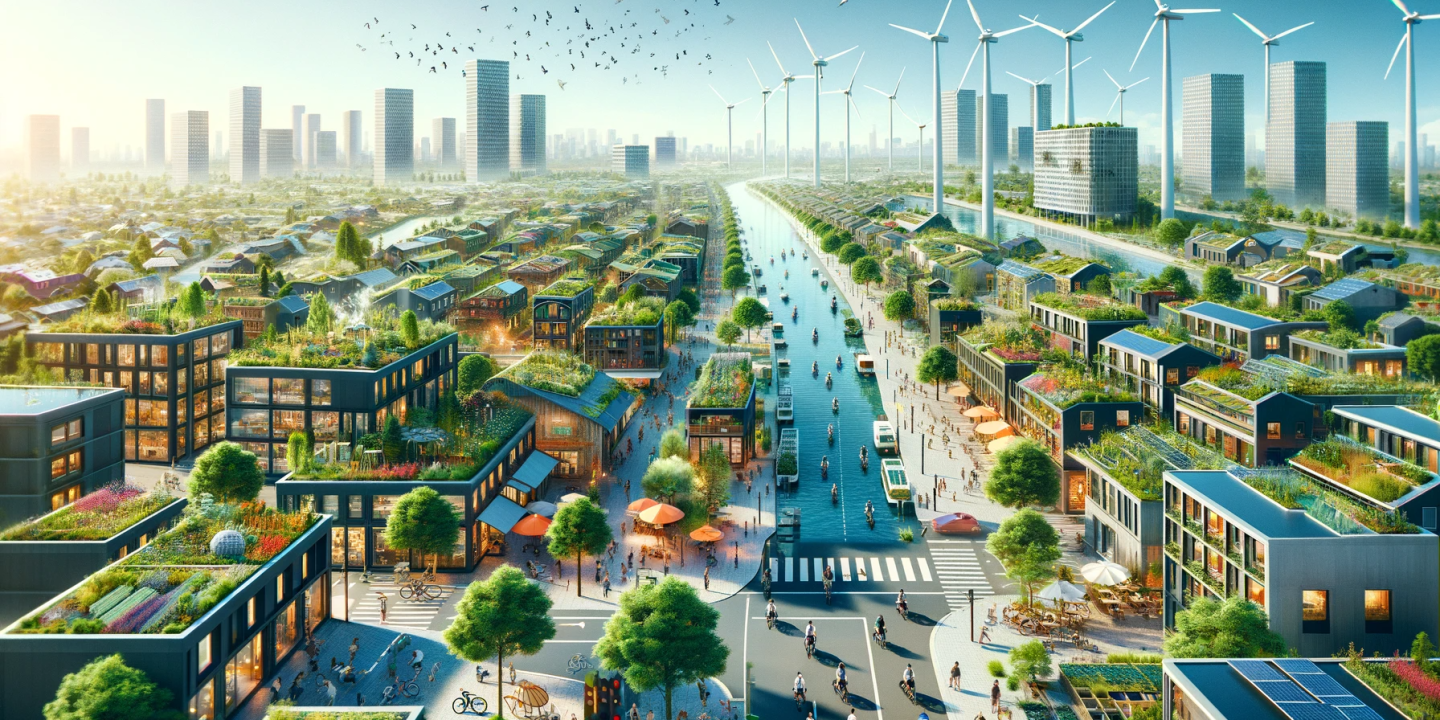
“For a Sustainable Future, Systemic Change is Inevitable”
June 2023
Dr Farhad Reyazat – London School of Banking & Finance
Introduction
As we stand at the crossroads of sustainability, the echoes of The Club of Rome’s seminal work, “The Limits to Growth”, continue to resonate half a century later. This groundbreaking report, published in 1972, served as a clarion call, challenging the very foundations of our growth-centric worldviews. It unveiled a future fraught with the perils of unchecked economic expansion, environmental degradation, and resource depletion, forecasting a potential collapse should global society fail to adjust its course. Today, the urgency for systemic change has never been more pronounced. With the world population soaring past 8.1 billion, our ecological footprint has expanded to levels that significantly outpace the Earth’s capacity to regenerate. The stark reality of climate change, with its array of catastrophic impacts—rising sea levels, extreme weather events, and biodiversity loss—underscores the imperative for a paradigm shift. Yet, amidst these challenges lies the opportunity for transformative change. By embracing systemic thinking, we can navigate towards a future that harmonises human prosperity with planetary health. Here we will elucidate why systemic change is not just beneficial but essential for a sustainable future.
Decoupling Economic Growth
Since the 1987 Brundtland report introduced the concept of “decoupling” economic growth from resource use, progress has been limited. Resource efficiency on a global scale has remained stagnant since 2000, with high-income nations using disproportionately more resources than their low-income counterparts. To ensure the health of our planet while improving living standards globally, we must stabilise resource use overall, while also recognising the need for increased energy and material consumption in poorer countries to achieve an equitable quality of life.
Resource efficiency, encompassing strategies like prolonging product lifespan and promoting reuse and recycling, is undeniably a part of the solution. However, it’s crucial to recognise that it’s not a one-size-fits-all remedy. The benefits gained through efficiency improvements are often counteracted by rising consumption linked to economic growth and rebound effects. Consequently, it’s unrealistic to rely solely on technological solutions to achieve the necessary decoupling of production and consumption from environmental damage on a global scale. Instead, what’s imperative is a holistic and systemic transformation. The ultimate objective should be the establishment of a global economy where sufficiency takes center stage. This entails meeting human needs through more intelligent and sustainable means than what is currently practiced today. In essence, the focus should shift from simply producing more to producing better and more intelligently.
Reducing our material footprint is inevitable.
The “material footprint,” the sum of raw materials extracted to fulfill consumer needs, illustrates the environmental impact of economic and consumption growth. From 43 billion metric tons in 1990, it surged to 92 billion by 2017, a significant increase that outpaced both population and economic growth. This trend, without intervention, could reach 190 billion tons by 2060. It’s critical to disconnect the growth of material consumption from population and economic expansion to mitigate environmental strain.
Population, material footprint and GDP growth index, 2000–2017 (baseline 2000=100)
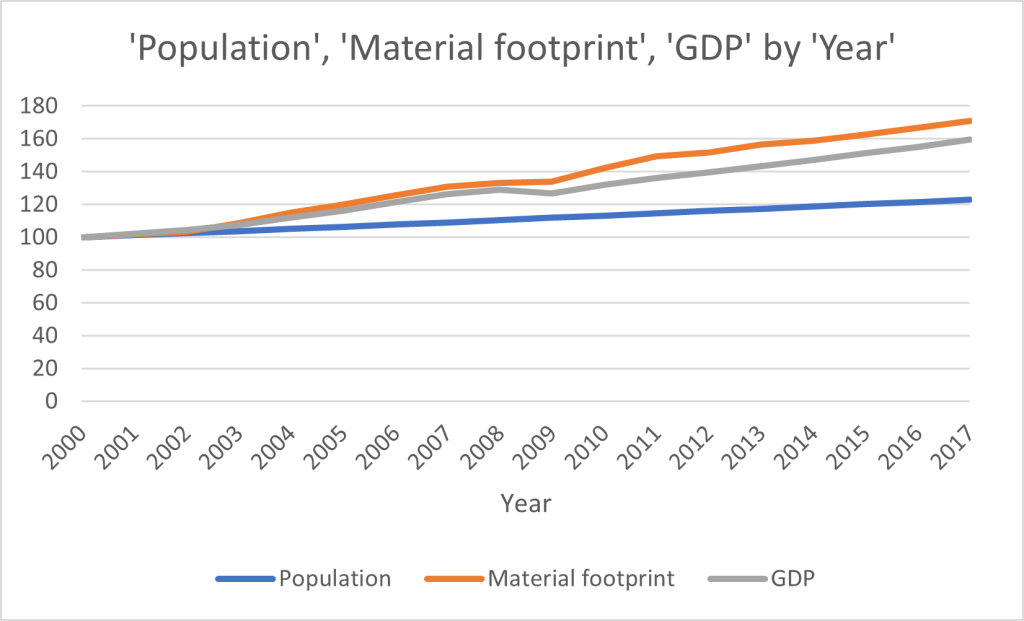
The above graph shows three trend lines representing ‘Population’, ‘Material Footprint’, and ‘GDP’ from the year 2000 to 2017. All three metrics are on an upward trajectory, suggesting that as the global population has increased, so have the GDP and the material footprint of human activity. The material footprint trend line, which measures the amount of raw materials used to meet consumption, is rising much faster than other two variables however almost in parallel with GDP, indicating that economic growth has been closely tied to material consumption. The graph illustrates the growing environmental impact of economic development and the increasing pressures on natural resources as the global population rises.
In High Income Nations, The lifestyle is substantially reliant on the exploitation of resources from less developed countries.
According to United Nations Statistics Division ( UNSD), a division of the Department of Economic and Social Affairs (DESA), The per capita material footprint has significantly increased, from 8.1 metric tons per person in 1990 to 12.2 metric tons in 2017—a 50% rise. High-income nations lead with a per capita footprint of 27 metric tons, substantially above upper-middle-income (17 metric tons) and low-income countries (2 metric tons). This indicates high-income countries’ consumption heavily depends on resources from abroad, with 9.8 metric tons of materials per person sourced from international markets.
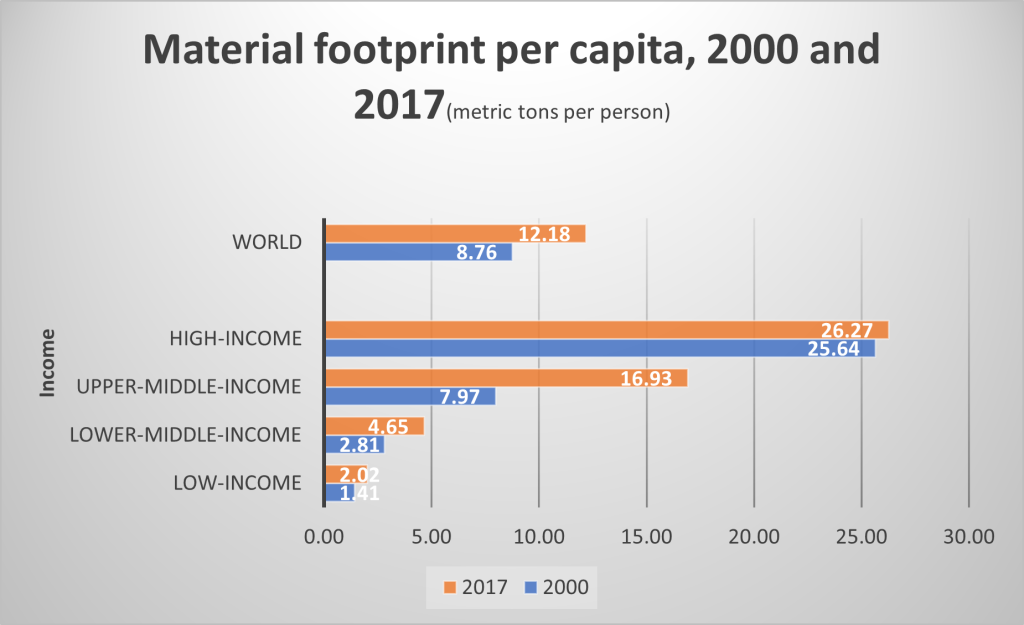
Domestic Material Consumption (DMC) quantifies an economy’s direct material usage for producing goods and services, incorporating both domestic and imported resources. Globally, DMC matched the material footprint, hitting 92 billion metric tons in 2017, with notable increases across all regions, especially in Eastern and South-Eastern Asia. This rise reflects infrastructure development in emerging economies and the relocation of material-intensive production stages from wealthier to less efficient countries. Although some regions have seen improvements in resource efficiency, global material intensity remained unchanged, highlighting the challenge of decoupling economic growth from material consumption.
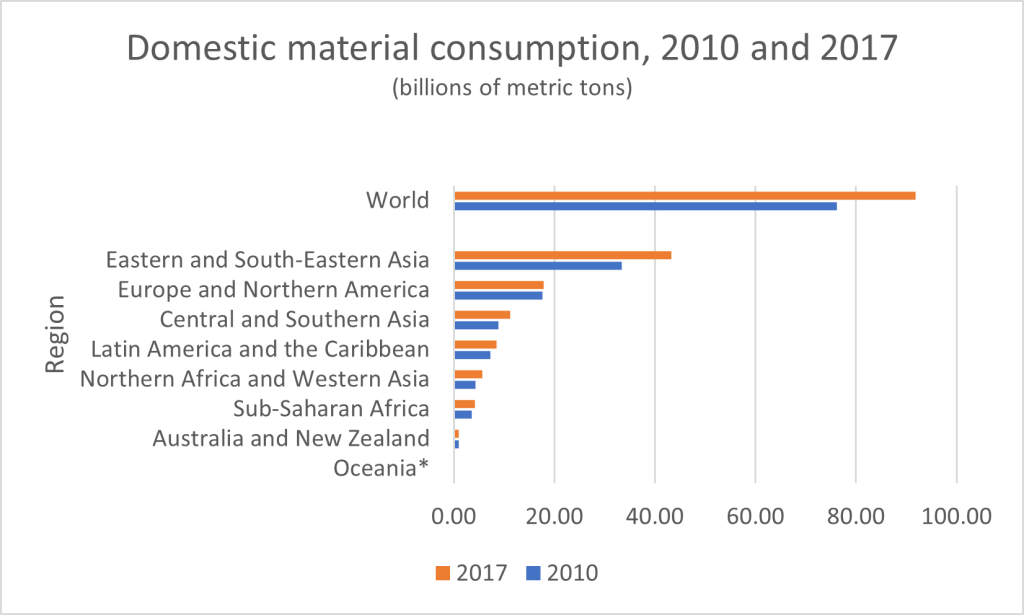
*excluding Australia and New Zealand.
The above bar chart illustrates the Domestic Material Consumption (DMC) in billions of metric tons for various regions in the years 2010 and 2017. DMC represents the total amount of material used by an economy. The blue bars indicate DMC for 2010 and the orange bars for 2017. From the chart, we can see that Eastern and South-Eastern Asia had the highest DMC in both years, with a significant increase from 2010 to 2017. Conversely, regions like Oceania and Australia and New Zealand had much lower DMC, indicating less material usage in their economies. Across all regions, there is a general trend of increased material consumption from 2010 to 2017. The chart also shows the global total DMC, highlighting a substantial rise over the seven-year period.
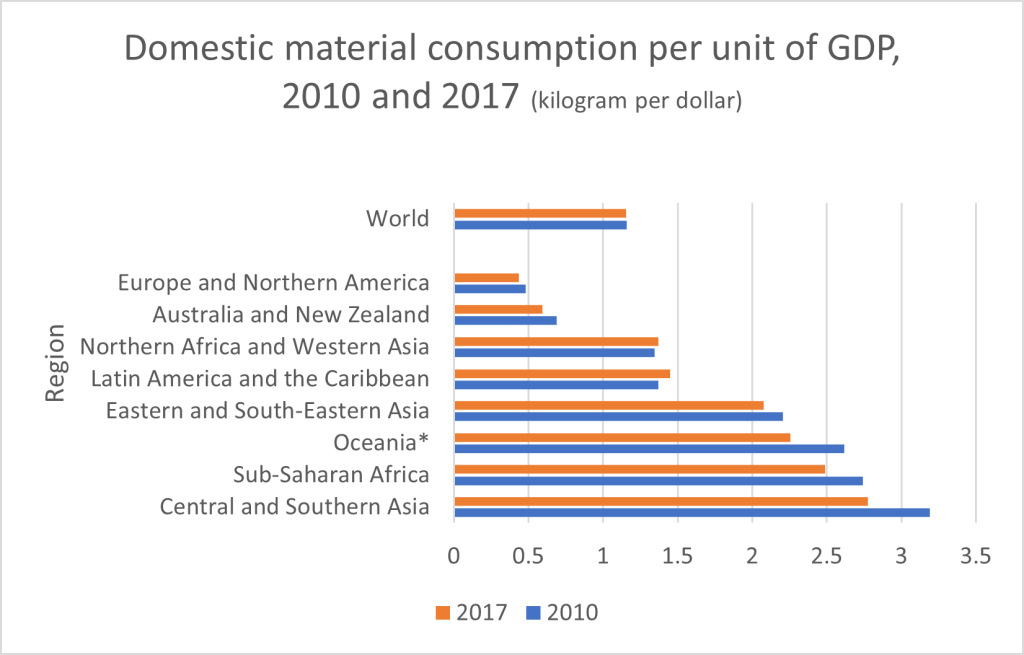
*excluding Australia and New Zealand.
This chart displays the Domestic Material Consumption (DMC) per unit of GDP for different regions between 2010 and 2017. DMC per GDP is a measure of the amount of materials used by an economy relative to its economic output, providing an indication of resource efficiency. The bars represent kilograms of materials consumed per dollar of GDP, with the blue bars indicating the year 2010 and the orange bars showing the year 2017. From the chart, we can observe that for most regions, the DMC per unit of GDP has increased from 2010 to 2017, suggesting a trend towards less resource-efficient economic growth. Europe and Northern America, as well as Oceania (excluding Australia and New Zealand), have some of the lowest material consumption relative to economic output, indicating higher resource efficiency. In contrast, regions like Eastern and South-Eastern Asia have shown a significant increase in material consumption per unit of GDP, implying a decrease in resource efficiency over this period.
The need for systemic change
The following pressing challenges are part of the argument for systemic change.
- The world’s CO2 levels have now exceeded 421 parts per million, levels not seen in 3 million years, exacerbating global warming and climate change.
- An estimated 13 million metric tons of plastic are dumped into the oceans annually, contributing to the destruction of marine ecosystems.
- The World Economic Forum (2021) reported that by 2050, the global population is expected to reach 9.7 billion, significantly increasing the demand on resources, such as water and food, which are already under severe stress.
- global temperatures have risen 1.2 degrees Celsius since pre-industrial times, pushing ecosystems to their limits.
- Meanwhile, economic inequality has soared, with the world’s richest 1% owning twice as much wealth as 6.9 billion people combined.
- Income inequality has reached alarming levels, with Oxfam reporting in 2020 that the world’s richest 22 men have more wealth than all the women in Africa.
- According to the IPCC, immediate and unprecedented systemic changes are required to limit global warming to 1.5°C above pre-industrial levels, necessitating a reduction in global carbon emissions by 45% from 2010 levels by 2030.
With over 1 million species at risk of extinction, the call for systemic change is not just urgent, it’s imperative. These figures highlight the multifaceted nature of the challenges we face, emphasising the critical need for systemic change to ensure a sustainable and equitable future. Addressing the multifaceted crises of climate change, malnutrition, inequality, poverty, and ecological degradation requires a deep understanding of the interconnected nature of our global challenges. Systemic change, leveraging systems thinking, emerges as a critical approach to grasp these complex interrelations, foresee unintended effects, and pinpoint impactful interventions. This perspective enables a comprehensive view of the dynamics between individuals, entities, and innovations, offering a strategic response to our intricate and evolving world. Systemic change entails a shift in the relationships within systems—be it ecological, economic, or social—aiming for transformative progress rather than incremental improvements, by focusing on the system as a whole rather than isolated components.
What is systemic change?
Systemic change refers to fundamental transformations in the structures, relationships, and processes within systems—such as social, economic, or environmental systems—that determine how these systems function. It goes beyond addressing individual parts or symptoms of issues, aiming instead to alter the underlying frameworks and mechanisms that produce the system’s outcomes. This approach recognises the interconnectedness of system components and seeks to bring about holistic change that can sustainably address complex challenges at their roots.
Why systemic change
Systemic change is crucial for achieving a sustainable future by reimagining societal fulfillment within responsible boundaries. It focuses on holistic system analyses to identify impacts on social, economic, and ecological fronts, spotlighting innovation and growth opportunities for sustainability goals. The Club of Rome highlights five transformative strategies for 2030: aggressively tackling poverty, reducing inequalities, overhauling energy to slash emissions, revolutionising food systems for nature, and prioritising women’s education and health. These strategies necessitate a fundamental shift in natural resource management to address the triple crisis of climate change, biodiversity loss, and pollution, aiming for a global economy focused on sufficiency rather than perpetual growth, ensuring the wellbeing of future populations within planetary limits.
This captures the essence of why systemic change is crucial for tackling global sustainability challenges. It emphasises the importance of understanding the interconnectedness of various issues to avoid superficial solutions. Adding to this, it’s important to consider the role of technology and innovation in enabling systemic change, as well as the need for collaborative efforts across governments, businesses, and communities to drive the transformative change required to address these complex challenges effectively. This change requires reimagining societal structures, economic models, and our relationship with the environment to address root causes rather than symptoms, ensuring a sustainable future for all.
A notable case study illustrating systemic change is Costa Rica’s transformation in environmental sustainability. Over the past decades, Costa Rica shifted from having one of the highest deforestation rates in the 1980s to doubling its forest cover by 2020, now encompassing over 50% of its land area. This change was driven by a comprehensive approach, including payment for ecosystem services, conservation policies, and renewable energy investments, showcasing how systemic changes in policy and community engagement can lead to significant environmental restoration and conservation outcomes.
Conclusion
In conclusion, as we navigate the complex challenges of our modern world, systemic change emerges as the key to a sustainable future. The urgency is evident in rising CO2 levels, plastic pollution in our oceans, a growing global population, and the pressing need to combat climate change. Economic and income inequality further underscore the need for transformation. Systemic change offers a holistic approach to address these multifaceted crises. It calls for a shift in how we view interconnected global issues and the imperative to take transformative actions, not incremental steps. This approach recognises that our future hinges on reimagining societal structures, economic paradigms, and our relationship with the environment.
References:
World Commission on Environment and Development. (1987). Our Common Future. Oxford University Press.
John Sterman, “Business Dynamics: Systems Thinking and Modeling for a Complex World, 2000, pp 5-10
The Limits to Growth”, Meadows et al., 1972, p23.
Disaster at the Top of the World”, Thomas Homer-Dixon, New York Times, August 22, 2010
Dent, Eric and Goldberg, Susan. 1999. Challenging Resistance to Change, The Journal of Applied Behavioral Science, Vol. 35, No. 1, 25-41.
United Nations Statistics Division. (2019). Sustainable Development Goal 12 Report. Department of Economic and Social Affairs.




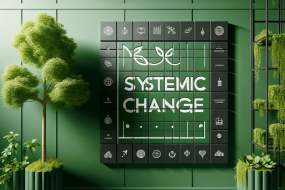

One reply on “For a Sustainable Future, Systemic Change is Inevitable”
The Real Person!
Author cuenta acts as a real person and passed all tests against spambots. Anti-Spam by CleanTalk.
Thanks for sharing. I read many of your blog posts, cool, your blog is very good.